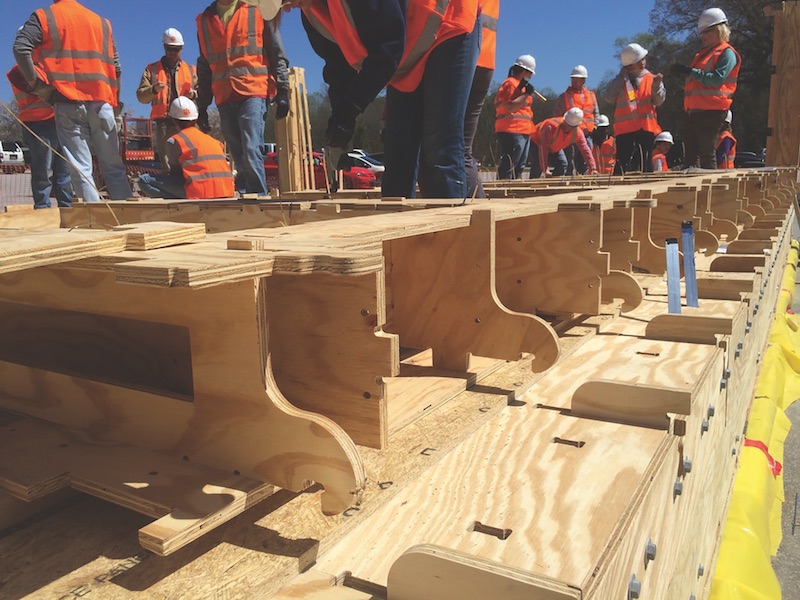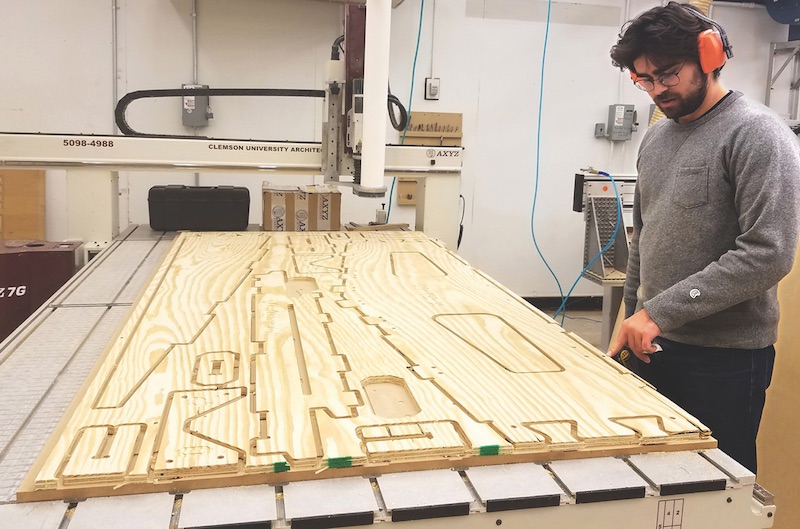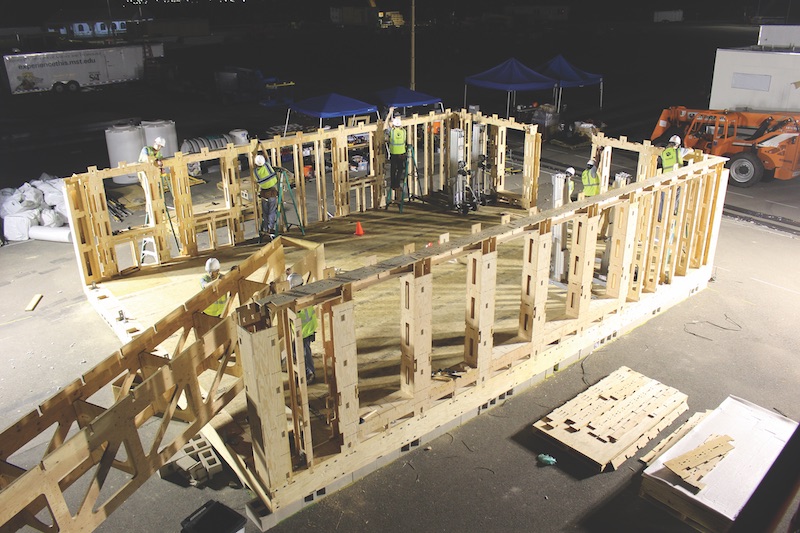Clemson University has been in the spotlight for the past few months thanks to its thrilling BCS National Championship win. But that doesn’t mean other departments within the university aren’t pulling their weight, too.
Clemson’s School of Architecture has recently received attention for its new framing method: the Sim[PLY] Framing System. The system is created from locally sourced plywood and uses a computer numeric control (CNC) fabricator to cut the components. After being pre-cut and pre-measured, the framing can be flat-packed for shipment, which allows for the use of small transport vehicles.
Beyond the sustainability and transportation benefits, Sim[PLY] provides strong thermal performance. “The wall cavity depth can be easily scaled up or down, for greater or less insulating value, as needed,” says Dustin Albright, Assistant Professor, Clemson School of Architecture. “Moreover, Sim[PLY] walls have minimal thermal bridging compared to inline framing. These measures would otherwise require offset studs or Larsen truss construction, if using conventional lumber.”
 The base of a Sim[PLY] Framing System wall prior to standing it. This wall was part of the initial prototype of the Indigo Pine House, Clemson’s 2015 Solar Decathlon entry. Courtesy Clemson University School of Architecture.
The base of a Sim[PLY] Framing System wall prior to standing it. This wall was part of the initial prototype of the Indigo Pine House, Clemson’s 2015 Solar Decathlon entry. Courtesy Clemson University School of Architecture.
What is really helping to set Sim[PLY] apart from other prefabricated structures is how it is put together. Thanks to a patent-pending interlocking tab-and-slot connection method, the structure can be assembled by unskilled labor without the use of power tools or nails. All that is required to build the structure are steel zip ties and screws.
The connection system means assembling the structure is similar to building a 3D puzzle, and because no nails are used, the system can be disassembled just as easily as it is assembled, without causing any structural damage.
“Non-destructive disassembly involves snipping the cable ties and popping the joints loose with a
mallet. The pieces are then ready to flat-pack and reuse elsewhere,”
says Albright.
Sim[PLY] was used to build CropStop in Greenville, S.C., an incubator kitchen and gathering place that allows crop owners to process their harvests to meet local demand for farm-to-table foods. Albright says Sim[PLY] is “gathering interest” from CropStop partners in Florida, as well.
 Clemson architecture student Paul Mosher cuts components for a full-scale mockup. Courtesy Clemson University School of Architecture.
Clemson architecture student Paul Mosher cuts components for a full-scale mockup. Courtesy Clemson University School of Architecture.
Related Stories
Affordable Housing | Apr 1, 2024
Chicago voters nix ‘mansion tax’ to fund efforts to reduce homelessness
Chicago voters in March rejected a proposed “mansion tax” that would have funded efforts to reduce homelessness in the city.
Standards | Apr 1, 2024
New technical bulletin covers window opening control devices
A new technical bulletin clarifies the definition of a window opening control device (WOCD) to promote greater understanding of the role of WOCDs and provide an understanding of a WOCD’s function.
Adaptive Reuse | Mar 30, 2024
Hotel vs. office: Different challenges in commercial to residential conversions
In the midst of a national housing shortage, developers are examining the viability of commercial to residential conversions as a solution to both problems.
Sustainability | Mar 29, 2024
Demystifying carbon offsets vs direct reductions
Chris Forney, Principal, Brightworks Sustainability, and Rob Atkinson, Senior Project Manager, IA Interior Architects, share the misconceptions about carbon offsets and identify opportunities for realizing a carbon-neutral building portfolio.
Reconstruction & Renovation | Mar 28, 2024
Longwood Gardens reimagines its horticulture experience with 17-acre conservatory
Longwood Gardens announced this week that Longwood Reimagined: A New Garden Experience, the most ambitious revitalization in a century of America’s greatest center for horticultural display, will open to the public on November 22, 2024.
Office Buildings | Mar 27, 2024
A new Singapore office campus inaugurates the Jurong Innovation District, a business park located in a tropical rainforest
Surbana Jurong, an urban, infrastructure and managed services consulting firm, recently opened its new headquarters in Singapore. Surbana Jurong Campus inaugurates the Jurong Innovation District, a business park set in a tropical rainforest.
Cultural Facilities | Mar 27, 2024
Kansas City’s new Sobela Ocean Aquarium home to nearly 8,000 animals in 34 habitats
Kansas City’s new Sobela Ocean Aquarium is a world-class facility home to nearly 8,000 animals in 34 habitats ranging from small tanks to a giant 400,000-gallon shark tank.
Market Data | Mar 26, 2024
Architecture firm billings see modest easing in February
Architecture firm billings continued to decline in February, with an AIA/Deltek Architecture Billings Index (ABI) score of 49.5 for the month. However, February’s score marks the most modest easing in billings since July 2023 and suggests that the recent slowdown may be receding.
Cultural Facilities | Mar 26, 2024
Renovation restores century-old Brooklyn Paramount Theater to its original use
The renovation of the iconic Brooklyn Paramount Theater restored the building to its original purpose as a movie theater and music performance venue. Long Island University had acquired the venue in the 1960s and repurposed it as the school’s basketball court.
Adaptive Reuse | Mar 26, 2024
Adaptive Reuse Scorecard released to help developers assess project viability
Lamar Johnson Collaborative announced the debut of the firm’s Adaptive Reuse Scorecard, a proprietary methodology to quickly analyze the viability of converting buildings to other uses.

















